Bismillah al-Rahman al-Rahim
Going around the Kaaba
Experiencing the Tawaf
Added August 01, 2003
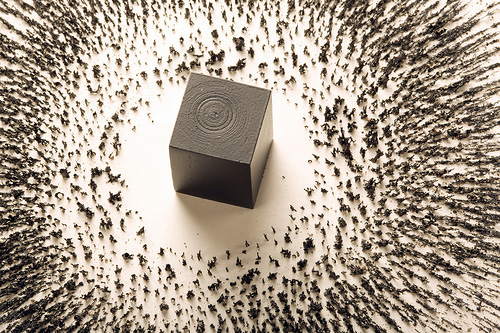
We often encounter the world with a mind overflowing with media images and our own imaginative projections - a sort of mental ecosystem which provides a psychological environment into which we can fit our experiences. These images, these landscapes of information, contour our outlook, adjust thoughts, and have a determining effect on how we perceive the world. They are the subtle technology of our brains, the hidden mechanism of the mind through which experience is made ‘safer’ and more digestible, and through which we avoid being overwhelmed by the ‘new’, or changed by the powerful impact of raw, unprocessed reality.
Raw: unaltered from its original state, not filtered or diminished in effect, exerting a forceful power and impact. This is the closest I can come to describing the intensity of the mental collision that occurred when I plunged from the cold of a Canadian winter into the powerful heat and movement of Mecca, the city at the heart of the Islamic world.
Sometimes an experience[1] goes beyond preset expectations. It piece by piece dismantles aspects of one's mental landscape or pierces through it, and overwhelms with the force of its presence. It causes a shift in perception, a rearranging of the terrain of the mind.
From a society in which religion and religious symbolism exist tenuously, vaguely, on the periphery of daily existence, I fell headlong into a concentrated centre of piety, where religion and its most potent symbols exist with the compact density and power of a black hole humming at the core of a galaxy. Where the raw symbolic and attractive power of religion are laid bare, divested of dross, concentrated into essence - into pure, palpable substance.
Here, in Mecca, the landscape is best described as raw, unfinished. Mountains lie in piles of crushed rubble as if pulverized by blows from a giant hammer. Vegetation is so sparse that only the closest inspection reveals small desiccated clumps of ragged bushes the same reddish brown hue as the rocks scattered along the rubble strewn slopes.
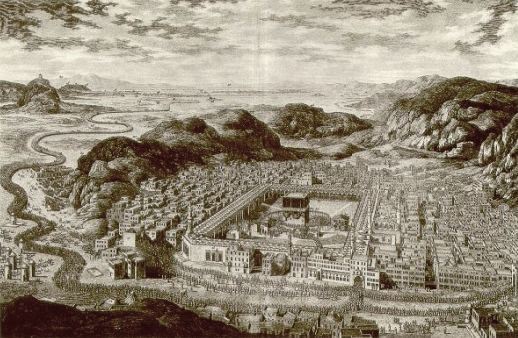
The mountains encroach into the heart of the city itself. Buildings emerge directly from the hills, their foundations following the craggy angles of steep slopes. No matter the inclination of the hills, there are jagged streets lined with dwellings rising along the rough contours nearly to the summits. The area immediately around the Kaaba (the cube shaped building in whose direction all Muslims face when praying) and the mosque surrounding it is encircled by sizeable hills - hills encrusted with shattered boulders and ragged stones. Upon these hills sits an uneasy mixture of modern steel and glass buildings intermixed with rough poured-concrete dwellings. Meandering stone walkways rise at difficult inclinations through their narrow alleys. In the flat pan of the valley that lies between the encircling hills sprawls the massive structure of the "Grand Mosque", and in the centre of the mosque's courtyard the simple form of the Kaaba.
Around the mosque is a wide ring of hotels for housing the millions of pilgrims who come each year for the hajj and the Umrah. Sprawling markets radiate in every direction, lining the streets between the hotels.
My first encounter with the grand mosque was a slow recession backwards into time. As I entered through the mammoth doorway and walked across the cool marble floors I left behind the dissonance of congested traffic and the commotion and agitation of Mecca's busy streets and markets. Endless rows of pillars and high archways floated past as I made my way through vast, warmly hued halls, lined with row upon row of thick, yielding, richly textured rugs. The timbre of the colors and textures was overwhelming. I was reminded of a hike through an old growth forest in Canada, where towering tree trunks rose to make an arched canopy of intertwined branches and the forest floor was a soft, silencing carpet of fallen leaves.
On the mosque's carpets families were seated, relaxing together. Old turbaned men reclined leisurely against immense pillars - children wearing traditional arab thawbs (floor length shirts) played between the columns, students leaned earnestly over papers, pens in hand, busy with schoolwork, the mosque their quiet study hall. I walked past devotees bent over Qur'ans, tasbeehs (prayer beads) turning endlessly between their fingers. Except for the occasional incongruity of a person dressed in a modern business suit and the ever-present Saudi security police in their drab khaki uniforms, I was now in a long ago world of flowing robes and beards, long thawbs (floor length shirts), turbans, chadors (women's head and body coverings), and white ihrams (the simple two piece sheets worn by pilgrims to Mecca). I walked past people praying, their foreheads pressed firmly against the cool floor. Others had rolled up the ends of the thick carpets to fashion pillows and were resting in the pleasant shade of the mosque's interior. An easy breeze flowed constantly between the multitude of pillars, through the high arches and under the domed ceilings removing the heavy heat of the day. And everywhere, pilgrims from every scattered corner of the world, of every complexion and ethnic variety, were busy with their devotions.
Finally my eyes fell upon the roofless central courtyard where, rising like a black monolith out of a circular plain of polished white marble, stood the Kaaba. Here was the compass point of Muslim prayers - a large cubical structure clothed entirely in a deep black cloth-covering embroidered with verses of the Qur'an (a black that appeared impossibly intense against the sunlit courtyard's white marble floor). It was a magical image, an ancient image, framed between contoured pillars. And like a waking dream it shimmered in the heat of the day, appearing to slowly pulse like a heartbeat as the dense heat induced the air to vibrate and rise in invisible currents. Surrounding it was an effortlessly turning human wheel - the endless circumambulation (tawaf) of the Kaaba by the pilgrims.
There was just too much to take in, too much newness, too much rich detail all around me, too much movement as I stood on the outskirts of the throngs of people engaged in worship around the Kaaba. It was all unfamiliar - my Canadian bred senses had no domestic perceptions they could latch onto to give them comfort. There was only the inadequate and incomplete jumble of impressions, images, and preconceptions I carried with me from books read, videos viewed, pilgrimage stories heard, pictures seen. I struggled to quieten my mind but my thoughts were hyperactive - kinetic. So much to process, to take in and digest. I gave up trying to marshal my thoughts into any coherent order and simply allowed the astounding visual panorama around me to flow into my consciousness.
Immersed in an ocean of religious symbols. everything around me seemed to possess depth and weight, everything emanated an impression of great substance. The architecture, the Kaaba, the masses of pilgrims in their ihrams[2], their movements, the sounds of uttered prayers and verses - it flooded in through the limited portals of my senses like floodwaters through a narrow chasm. Gradually, the very materiality of the things around me receded and it seemed as if I was watching only forces in motion, symbols that tugged at my mind but whose meaning I could not yet penetrate.
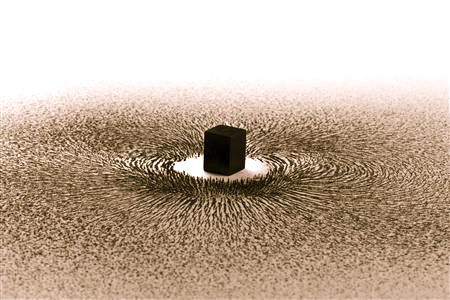
I stood and watched the tawaf for a long time. The tawaf consists of walking around the Kaaba seven times. Each circuit begins with raising the right hand in a salute of acknowledgment towards the black stone (called the hajar-al-aswad) embedded in one corner of the Kaaba. The raising of the hand is a substitute for kissing this stone since it is almost impossible to get close enough to accomplish that - there is forever a tight knot of people around the stone, all pressing inward in an attempt to touch or kiss it. If you approach too close to this endlessly forming and reforming knot you are squeezed so forcefully that your feet leave the ground and you have no control over where you are carried.
Then, the gravitational presence of the Kaaba tugged at me and I was drawn into the tawaf. Immediately, I was caught in the press and flow of bodies. Heat and sweat engulfed me and the physical presence of the crowd of pilgrims pressing in around me became the direct focus of my concentration. I wiped at the rivulets that streamed off my forehead and walked forward swept along by the inundating flood of humanity in which I was immersed.
The crowd shifted and flowed around me - an organized chaos of particles they bumped along in a curved path around the Kaaba like electrons in orbit around a nucleus. Everyone was focused inwardly on their own individual recitations and concentrating on their own tawaf. In front of me an aged blind man, his pure white hair and beard glowing in the sun, leaned on a wooden staff as he performed his circuits unguided except by the sounds of the crowd and the movement of bodies around him. His free hand would rise occasionally, palm upwards in supplication as he would speak a prayer. What was it like to do this tawaf in darkness, with no visual cues, no images to process. Did he sense the looming presence of the Kaaba by his side, was he able to turn his consciousness completely inward without the incredible spectacle of the tawaf to distract him? I closed my eyes and for a few steps walked blind.
A swirling eddy of sounds came and went as people passed by or as I passed by them. Some traveled in groups loudly reciting Qu'ran'ic verses in unison, some whispered to themselves - others moved in silence and I knew their presence only by their touch as they brushed past. The sounds ebbed and flowed in my consciousness as if I was a leaf floating on a river of prayers - currents and eddies of supplications tugging my consciousness this way and that.
When I opened my eyes the blind man was far ahead, moving confidently through the thick crowd, his staff seeming more like the staff of Moses than a crutch to lean upon. I looked about me as I moved forward. Some pilgrims were in wheelchairs, some frail and weak with age were being carried on rough bamboo litters or on hospital stretchers, some went around in tight groups, arms linked together so as not to separate in the crowd. Some shuffled along in their tawaf, others dodged in and around the crowd as if in a race to complete their circuits. New people continuously entered the tawaf, while those who had finished theirs cut across the crowd and exited the circle.
Each time I approached the corner where the black stone lay it was like approaching a zone of agitated turbulence - a tangle of bodies struggled to reach the stone as if drawn by a powerful magnet. Others only paused momentarily, lined up in a straight row radiating out from the stone as if they were iron filings caught on a magnetized strip angling away from the corner of the Kaaba. Then they would wave an acknowledgment towards the stone and continue on with their tawaf.
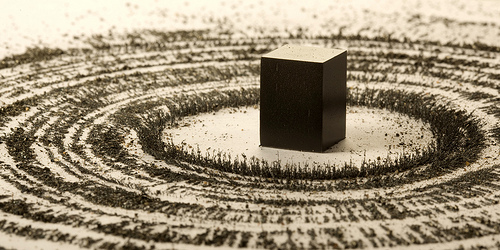
Through all the circuits, the attention-commanding cube of the Kaaba loomed impressively at my left side. It's presence was powerful, intense, imposing - the extreme simplicity of it's shape adding to its stature. There was a kind of bewitching beauty to the Kaaba - here was a building stripped to it's most basic fundamentals - four walls and a roof - yet it captivated the eyes more forcefully than the architectural marvels of the mosque surrounding it. There was a wall of unmoving bodies encircling it - devotees clinging prayerfully to its cloth covered surface, their cheeks pressed firmly against its sides. It was as if those who drew too near were simply overwhelmed by its gravity and then frozen static at some timeless event horizon. And indeed, inside the Kaaba's walls was a singularity where the outward rules of religion crumbled and only the essence remained, where prayer could be performed in any direction since there lay the innermost heart of the great wheel of the Islamic galaxy, the pole within which the believer's compass spins, bewildered.
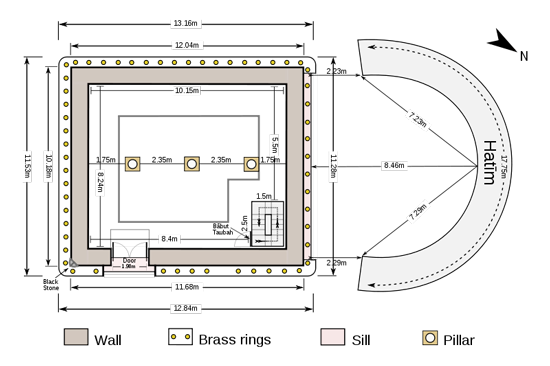
My eyes took in the faces swirling around me - a vast spectrum of complexions and hues contrasting yet complementing each other, lines of great age and experience alongside the smooth faces of youths. A young woman holding her husband's hand came past me. He intoned prayers in a beautiful rhythm and tears spilled down her face. Then they were past and his recitation faded in the generalized murmur of the crowd. I grew aware of the plenitude of tears around me - some only moistening the corners of eyes, others inundating and softening deep lines in weeping faces. In these faces there was a complete absorption in the present moment. As their bodies went around the Kaaba, it seemed the real tawaf was accomplished by their hearts. When my seven circuits were complete, I felt reluctant to leave the circle and it took an active force of will to break out of the curving path and move away from the Kaaba.
When I was in the tawaf it had seemed somewhat chaotic, a complex, shifting interplay of human traffic as the masses of pilgrims sought individual routes through the crowds, their attention focused inward, each following their own meandering orbit around the Kaaba.
But when later I observed the tawaf from above - from the second floor balconies of the mosque - it appeared as a smoothly turning wheel - a masterpiece of co-ordination. All the close-up complexity, the seeming chaos of individual behaviours vanished and a beautifully meshed rotation appeared - a slow revolution around an unmoving, immobile axis. There was such a gracefulness, such a superfluidity to the motion that the individuals in the crowd receded from my consciousness and I imagined I was gazing at some vast otherworldly symbol - the slow pivot of existence itself around a single fixed, immovable principle. It was as if the outward movements of the rituals[3] provided a form, a structure that reflected, through the ritual's physical movement, a stunning spiritual geometry.
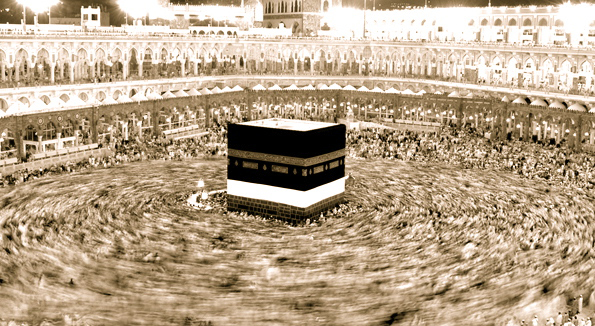
It reminded me of a verse in the Qur'an in which all the human souls, from the first to the last are brought into the presence of God in a realm of pre-material existence. Each acknowledges God as Rabb (as their Sustainer) before entering into their earthly existence, before being born into this world.
Before man emerged into this world - God asked all the human souls “Am I not your Lord? And they replied, Yes! Of this we bear witness!” (Sura 7:172)
The tawaf[4] was like a symbol of these human souls circling God's presence, acknowledging Him as Rabb at each passing of the hajar-al- aswad (the black stone). Each circuit was like a descent through the different layers of existence until we leave the tawaf and enter the life of this world (the place of separation) after one final acknowledgment of God as Rabb. The hajar al-aswad seemed to me like the signet ring of a King - touched or kissed to acknowledge His Lordship.
Or perhaps the tawaf is like the names of all things in existence (the names or realities taught to Adam before he emerged on the earth - as mentioned in the Qur'an). These realities circle in God's knowledge until the proper moment arrives for them to manifest in the material world. And then they descend through the layers and levels of existence till, entering the realm of time and space and cause and effect, they emerge into earthly existence. As a result it is said that everything in existence (every reality, every “name”) is a messenger from the unseen world.
As I left the tawaf, as I left the Kaaba, as I left the mosque, and as I left Mecca for other destinations, I felt both a powerful pang of separation and a comforting closeness towards what I left behind. The separation arose from being cut off from that which had so intensely attracted and impacted my consciousness. The closeness emerged because my direct experience of an ancient transcendental rite had inwardly magnetized me. I knew that even after I flew back to the comfort of home, some essential part of my consciousness, some essential part of my heart, would always turn, unbidden, like a compass needle to face the simple structure of the Kaaba.
*
To be notified when new articles are added to this site, please follow @i_from_i (islam from inside). Or, if you prefer, subscribe to the islam from inside RSS feed.
Footnotes
-
1 – About this Article – The first draft of this article (Going Around the Kaaba) was originally written as an email at an internet cafe in Mecca in November 2000. I was there with my family to perform the Umrah, which is a sort of mini Hajj - a minor pilgrimage which, unlike the Hajj, can be performed at any time of the year. After performing the Umrah, I visited the Kaaba many, many times - at all hours of the day and night, each time participating in the tawaf (circumambulation around the Kaaba) and deliberating on why it had such a powerful attraction and effect on me. The small portion of the experience that I was able to absorb and articulate was poured out into an email shortly before the midnight closing time at the internet cafe. That email forms the core of this piece.↵
-
2 – Wearing the Ihram – Wearing the ihram was the first step in a series of ritualistic actions I would be performing as part of my umrah - rituals about whose purpose I had only some feeble intellectual notions - notions that did little to prepare me for the reality of the actual experience.
Dressed in the white sheets of my ihram[5], I felt a world away from my other life. A life where religious rituals, beyond a few personal ones, existed only as minor tributaries to the great flow of secular life and its relentless activity and distractions.
The ihram is the clothing worn during the hajj (the greater pilgrimage) and during the umrah (the lesser pilgrimage). Umrah is an abbreviated version of the Hajj. Hajj is the greater pilgrimage which Muslims, if able, are to perform at least once in their life. The Umrah is a shortened and simplified version of Hajj and can be performed at anytime, except during the actual days of the Hajj. However, it encompasses within it many of the key rituals of the Hajj, including the circumambulation (tawaf) around the Kaaba. As such it encompasses much of the spirituality of the Hajj without the overwhelming crowds of the Hajj season.
The ihram is a great leveller. Status, position, any external signs of your standing, your identity, your likes, dislikes, your tastes, the subtle or blatant social signals given out by your clothes, the cultural, national, institutional, or organizational identities indicated by them, your fashion sense or lack thereof, the trappings of your self mirrored in your garments, your personal image, all are erased, deleted, shredded, obliterated, replaced by two simple pieces of cloth. The outward self I was comfortable with had evaporated.
At first, whenever I moved, my ihram came into the forefront of my consciousness. It was such an unfamiliar dress and I was already in a state of simultaneous nervousness and anticipation. The ihram kept drawing my mind away from the Umrah to come and towards my own physical self, toward my self-consciousness at this strange clothing - clad in white sheets like those used to swathe the dead. Gradually, as I neared the centre of Mecca and the ihram became a commonplace sight, this self-consciousness faded and then fell away altogether. The play of my ego, inasmuch as it was connected with my outward appearance and bearing, fell away and in effect became irrelevant. My focus began to shift inward.↵
-
3 – Traces of the Past – I performed the rituals of the pilgrimage, especially the tawaf (circumambulation) around the Kaaba, over and over again. There is something very compelling about this rite. I felt drawn to it as toward something mysterious and strangely beautiful. It is as if the outward movements of the rituals correspond to some deeper reality and through this congruity a physical rite is able to crack open a door to a more majestic structure. Almost as if these rituals provide a stepping stone, a formalized entryway to the experience of something deeper.
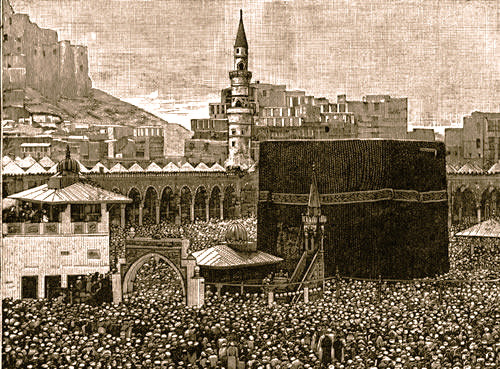
It seemed that there was a deeper reality present at the Kaaba but initially the noise and churn of my mind prevented access to it. If a place collects the traces of all that happens on its soil, then it would require a certain quietness of mind to perceive what has gathered over the generations, and a hardness or agitation of mind to render it invisible. Around this Kaaba, Prophets had circumambulated. If I visit a place that resonates with the tread of those who had dwelt here, passed through here and worshipped here, and I perceive no trace of their perfume, then it is as if my visit was to nothing but rocks and stones. A deep and measured reflection during the rituals almost seems to superimpose an unseen spiritual realm over the physicality of the rites like a transparent overlay laid over a blueprint.↵
-
4 – The Machine Tawaf – In the article I've focused on the beauty of the pilgrimage, but there were many jarring experiences that frequently threatened to shake one loose from any transcendent state of mind the pilgrimage might trigger. These were too numerous to cover in this brief article although I'll mention a few of the lesser culprits here.
The Saudi government has built a lengthy enclosed extension angling off one face of the grand mosque. This high ceilinged extension completely encompasses Safa and Marwah (two hills between which the pilgrim walks seven times as part of the Umrah and Hajj - a ritual called “sayy”), and the rough ground of the shallow valley between them is now a polished marble multi-lane walkway (with two centre lanes, surrounded by guardrails, reserved for wheelchairs). The enclosure is powerfully air conditioned with massive blowers that direct the chilled air with great force onto the pilgrims. For a moment, the cold blasts evoked in me a feeling of disorientation, of feeling out of place, or out of time. The word sayy means "effort". This ancient ritual and the air-cooled ease with which I was accomplishing a once difficult task, jarred me momentarily. This was like a walk in an air-conditioned shopping mall. It was a blatantly asymmetrical element disrupting a beautifully symmetrical design.
This happened again and again during the Umrah and during the following days when I returned (sans ihram) many times to the Kaaba to perform the tawaf and explore the surroundings. Most of the modern elements at work in the haramain were well concealed or of a common enough type that it did not startle or intrude on the senses - the heat sinks under the marble flooring to keep it cool under direct sunlight, the discreetly placed loudspeakers that carried the sounds of Qur'anic recitation through the many halls of the mosque. But other aspects intruded strongly. A ring of modern hotels dominated the skyline seen from the inner courtyard of the mosque. Instead of the rugged hills of Mecca, an ugly commercial panorama was intrusively visible directly above the roofline of the mosque.
During the tawaf people would be temporarily moved away from the Kaaba and Zambone-like machines would emerge into the central courtyard. Momentarily the human circumambulation (tawaf) would be displaced by a strange surrealistic machine tawaf as the zambones would wash and polish the white marble floor around the Kaaba while they slowly and eerily completed their mechanized circumambulation, motors humming and brushes whirling.
I performed the rituals of the pilgrimage, especially the tawaf (circumambulation) around the Kaaba, over and over again. There is something very compelling about this rite. I felt drawn to it as toward something mysterious and strangely beautiful. It is as if the outward movements of the rituals correspond to some deeper reality and through this congruity a physical rite is able to crack open a door to a more majestic structure. Almost as if these rituals provide a stepping stone, a formalized entryway to the experience of something deeper.↵
-
5 – Adjusting to the Ihram – I'm standing in the hotel lobby wearing one white sheet around my waist and another one draped over my shoulders. I'm still not completely comfortable with the fact that I have nothing on under the sheets. And the one around my waist is held up only by some judicious tucks made as tightly as I could manage to make them - the thought of it slipping off or coming undone hovers constantly in my mind.
So I'm standing a little nervously in the hotel lobby - it's late at night, my family and I have just arrived in Mecca and we're hoping to do a speedy check-in so that we can go over to the grand mosque which houses the Kaaba and perform our Umrah (the lesser pilgrimage) before it gets too late and the kids get over tired. We're all still jet lagged, having come all the way from Canada, with extraordinarily bad connections and long airport transits along the way.
I'm still not used to my ihram, the pilgrimage garb, which for men, has some very strict conditions determining the material used and the manner in which it is worn. A safety pin to secure the cloth around the waist, an underwear underneath, just in case the towel worked it's way loose - these would have been some mental comfort to me - but nothing is allowed except two unstitched pieces of cloth and a simple bag or money-belt for carrying cash.
I keep reminding myself that millions upon millions of pilgrims wear this throughout the year when performing the Umrah and during the hajj. But that thought is not a great comfort at this particular moment. I'm eager to get up to the hotel room so that I can readjust my garb and more importantly, my mental focus, before performing the rituals of the Umrah.
But the hotel clerk seems determined not to make life so easy for us. He says he knows nothing about the reservations our travel agent made weeks ago, but is willing to give us a room at an unreasonably inflated rate. He also insists we hand over all our passports for the duration of our stay. An hour of haggling goes by - the clerk calls the manager - but they clearly know they have us at a disadvantage (after all we're in pilgrim garb) and with a strange, unfathomable reasoning process, press the fact home by telling us that, since we're pilgrims - we're their guests - and so we shouldn't haggle with our hosts in the holy city of Mecca. We're momentarily stupefied by this convoluted logic - then we continue to haggle.
The kids are asking how much longer this is going to take.
I check the cloth around my waist - it's still holding up, if a little loosely now. We finally come to an arrangement that provides approximately the same level of satisfaction as would be gained by obtaining a few minor concessions from a mugger in an alleyway. They drop the price of the room slightly, they only make photocopies of our passports, and then hand over the key which is attached to an enormous half-pound key chain. I clutch at my ihram and head for the elevator.
It's the size of a coffin, has no air conditioning, and takes about five minutes to get to the ninth floor where our room is. The room turns out to be an expanded version of the elevator - with the previous guests garbage (empty bottles and cans, food bags, bits of paper, used plastic forks and spoons and other assorted trash) overflowing from under the beds which have somehow been squeezed into the tiny room. I make a mental note to have a word with our travel agent about this "newly refurbished" hotel she arranged for us.
I tighten up my ihram, loosen up my mind, firm up my intention, and we set out to perform the Umrah.↵
